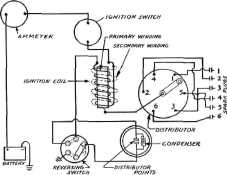1942 - 1947 CHEVROLET SHOP MANUAL
Section 12 - Electrical System
|
|
|||
|
12-23
|
|||
|
|
|||
|
The switch contacts are so arranged as to provide
a wedging action when contact is made thus
insuring a good connection, and
also giving the contacts a
wiping action which tends to keep them
clean.
DRIVE MECHANISM
The drive pinion and over-running clutch is a
self-contained unit. If it becomes
damaged in any way the complete unit should be replaced.
However, should the spring be broken or the sheave
become worn, these parts may be
easily replaced by
compressing the spring to uncover the lock ring
|
reversing switch, through the switch to the distributor,
across the breaker points and back to the
grounded terminal of the reversing
switch, and back to the
negative terminal of the battery, Fig. 51.
|
||
 |
|||
 |
|||
|
Fig. 50-Starting Motor Drive Mechanism
in the tube part of the drive mechanism. Removal of the lock ring
permits removal and replacement
of both the sheave and spring. Fig. 50 shows a layout
of the drive mechanism parts.
THE IGNITION
SYSTEM
The power in a gasoline engine is derived from
the explosion of gas in the engine
cylinders. In order to
explode this gas, an electric spark is made to jump a small gap
inside the cylinder or combustion
chamber. The ignition system furnishes this spark. The spark
must occur in each cylinder at
exactly the proper time and the sparks in the various cylinders
must follow each other in the proper order or sequence. To accomplish
this, the following parts are
used: The battery which
furnishes the electrical energy; the ignition coil which transforms
the battery current to high tension
current which will jump the gap in the spark
plug; the mechanical breaker
which opens and closes the
primary circuit at the proper time; the distributor which delivers the
spark to the proper
cylinder; the spark plug which provides the gap
for the spark to jump in the
engine cylinder: the wiring
which connects the various units; the ignition
switch for disconnecting the battery when it is
desired to stop the engine.
OPERATION
When the ignition
switch is closed, current flows
from the battery positive to the starter switch, over
the wire to the ammeter and then
to the ignition switch,
through the switch to the coil. The current
now passes through the primary
winding to the
|
|||
|
Fig. 51-Ignition Circuit
|
|||
|
Current flowing through this circuit builds up a
magnetic field about the coil.
When the breaker points open, the current tends to keep on flowing
and surges into the condenser, attracting a positive
charge on one side and a negative
charge on the other. A
fraction of a second after the breaker points open, the counter
pressure in the condenser
overcomes the surge pressure on the line and the condenser discharges
from the positive charged side back through the primary winding of the
coil in the opposite
direction to the primary current, through the battery to the ground
and back to the grounded
side of the condenser, equalizing the two sides of the
condenser. The discharge current from the condenser, passing over the
primary winding tends to reverse
the polarity of the coil and results in a very rapid demagnetizing of
the coil. This rapid movement
of the lines of force across the large number
of turns of the secondary winding
induces a current of very
high voltage, which flows from the secondary winding to the high
tension terminal of the coil,
then to the distributor, across
the distributor rotor to
the spark plug, across the gap between the plug
points to the ground and back to
the other end of the
secondary winding, completing the circuit.
CONDENSER
The operation of the condenser is many times
misunderstood by the average
service man. It is one of
the most important units in the ignition system. In order to
understand its action and function, we will show a water analogy of
condenser action.
|
|||
|
|
|||